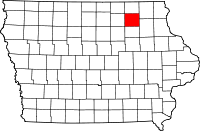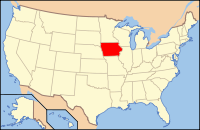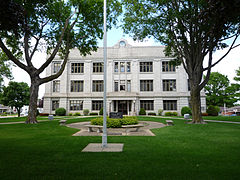- Chickasaw County, Iowa
-
Chickasaw County, Iowa Chickasaw County County built in 1929
Location in the state of Iowa
Iowa's location in the U.S.Founded 1851 Seat New Hampton Area
- Total
- Land
- Water
505.48 sq mi (1,309 km²)
504.64 sq mi (1,307 km²)
0.84 sq mi (2 km²), 0.17%Population
- (2010)
- Density
12,439
24.6/sq mi (9.5/km²)Time zone Central: UTC-6/-5 Website www.chickasawcoia.org Footnotes: Population [1] Chickasaw County is a county located in the U.S. state of Iowa. It was named for the southern Indian Nation whose chief was Bradford. The population was 12,439 in the 2010 census, a decline from 13,095 in 2000.[1][2] Its county seat is New Hampton.[3]
Contents
Geography
According to the 2000 census, the county has a total area of 505.48 square miles (1,309.2 km2), of which 504.64 square miles (1,307.0 km2) (or 99.83%) is land and 0.84 square miles (2.2 km2) (or 0.17%) is water.[4]
Major highways
 U.S. Highway 18
U.S. Highway 18 U.S. Highway 63
U.S. Highway 63 U.S. Highway 218
U.S. Highway 218 Iowa Highway 24
Iowa Highway 24
 Iowa Highway 27
Iowa Highway 27 Iowa Highway 346
Iowa Highway 346
Adjacent counties
- Howard County (north)
- Winneshiek County (northeast)
- Fayette County (southeast)
- Bremer County (south)
- Butler County (southwest)
- Floyd County (west)
- Mitchell County (northwest)
History
Chickasaw County was founded on January 15, 1851. It was named after the Chickasaw tribe, which lived in the Southern United States at the time.
The first white settlers came in 1848 and the first county seat was from 1854 in Bradford, in the southwestern corner of the county. In the spring of 1857, the seat was moved to New Hampton, located near the geographic center, and was then called Chickasaw Center. The first offices needed of the county government were housed in private houses and the school building. In 1865, the first courthouse was erected, which was expanded in 1876, and completely destroyed by a fire on March 26, 1880.[5]
Demographics
Historical populations Census Pop. %± 1860 4,336 — 1870 10,180 134.8% 1880 14,534 42.8% 1890 15,019 3.3% 1900 17,037 13.4% 1910 15,375 −9.8% 1920 15,431 0.4% 1930 14,637 −5.1% 1940 15,227 4.0% 1950 15,228 0% 1960 15,034 −1.3% 1970 14,969 −0.4% 1980 15,437 3.1% 1990 13,295 −13.9% 2000 13,095 −1.5% 2010 12,439 −5.0% Iowa Data Center [2] 2010 census
The 2010 census recorded a population of 12,439 in the county, with a population density of 24.632/sq mi (9.510/km2). There were 5,679 housing units, of which 5,204 were occupied.[1]
2000 census
As of the census[6] of 2000, there were 13,095 people, 5,192 households, and 3,644 families residing in the county. The population density was 26 people per square mile (10/km²). There were 5,593 housing units at an average density of 11 per square mile (4/km²). The racial makeup of the county was 98.75% White, 0.05% Black or African American, 0.03% Native American, 0.27% Asian, 0.01% Pacific Islander, 0.29% from other races, and 0.60% from two or more races. 0.63% of the population were Hispanic or Latino of any race.
There were 5,192 households out of which 31.90% had children under the age of 18 living with them, 60.70% were married couples living together, 6.30% had a female householder with no husband present, and 29.80% were non-families. 26.10% of all households were made up of individuals and 13.70% had someone living alone who was 65 years of age or older. The average household size was 2.48 and the average family size was 3.00.
In the county the population was spread out with 26.10% under the age of 18, 6.90% from 18 to 24, 25.60% from 25 to 44, 23.40% from 45 to 64, and 17.90% who were 65 years of age or older. The median age was 40 years. For every 100 females there were 100.10 males. For every 100 females age 18 and over, there were 96.50 males.
The median income for a household in the county was $37,649, and the median income for a family was $44,306. Males had a median income of $30,099 versus $21,309 for females. The per capita income for the county was $18,237. About 5.90% of families and 8.30% of the population were below the poverty line, including 9.90% of those under age 18 and 7.70% of those age 65 or over.
Chickasaw County posted the highest county unemployment rate in Iowa in the 2000 Census with 8% of the workforce unemployed. This figure, however, was still relatively low compared to the problems faced by many other counties in the Midwest.
Localities
Cities
Townships
See also
- National Register of Historic Places listings in Chickasaw County, Iowa
- The Chickasaw County Courthouse Article
References
- ^ a b c "Population and Housing Occupancy Status: 2010 - State -- County". United States Census Bureau American FactFinder. http://factfinder2.census.gov/faces/tableservices/jsf/pages/productview.xhtml?pid=DEC_10_PL_GCTPL2.ST05&prodType=table. Retrieved March 9, 2011.
- ^ a b "Data from the 2010 Census". State Data Center of Iowa. http://www.iowadatacenter.org/archive/2011/02/feb10. Retrieved March 9, 2011.
- ^ "Find a County". National Association of Counties. http://www.naco.org/Counties/Pages/FindACounty.aspx. Retrieved 2011-06-07.
- ^ "Census 2000 U.S. Gazetteer Files: Counties". United States Census. http://www.census.gov/tiger/tms/gazetteer/county2k.txt. Retrieved 2011-02-13.
- ^ Chickasaw County
- ^ "American FactFinder". United States Census Bureau. http://factfinder.census.gov. Retrieved 2008-01-31.

Mitchell County Howard County Winneshiek County 
Floyd County 
 Chickasaw County, Iowa
Chickasaw County, Iowa 

Butler County Bremer County Fayette County Municipalities and communities of Chickasaw County, Iowa Cities Alta Vista | Bassett | Fredericksburg | Ionia | Lawler | Nashua‡ | New Hampton | North Washington | Protivin‡
Townships Bradford | Chickasaw | Dayton | Deerfield | Dresden | Fredericksburg | Jacksonville | New Hampton | Richland | Stapleton | Utica | Washington
Unincorporated
communityFootnotes ‡This populated place also has portions in an adjacent county or counties
Categories:- Iowa counties
- Chickasaw County, Iowa
- 1851 establishments in the United States
Wikimedia Foundation. 2010.


